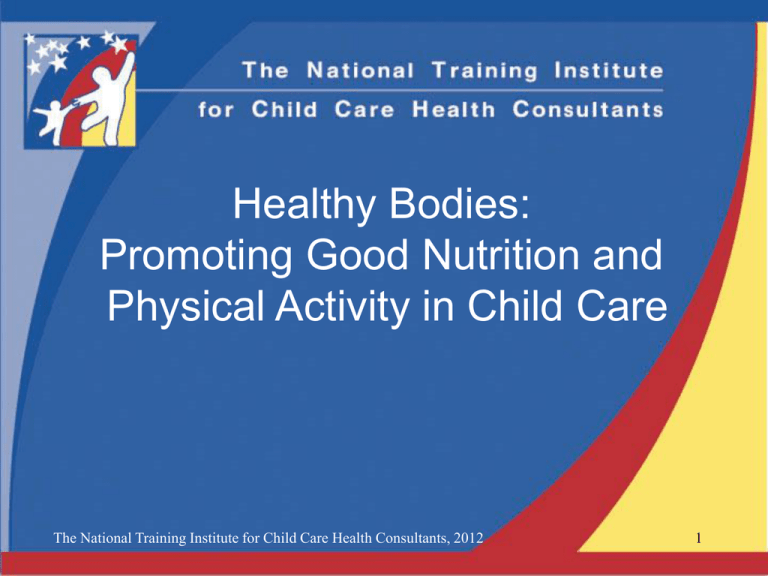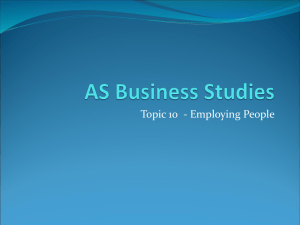Healthy Bodies Slide Presentation - National Training Institute for
advertisement

Healthy Bodies: Promoting Good Nutrition and Physical Activity in Child Care The National Training Institute for Child Care Health Consultants, 2012 1 Name Agency Date The National Training Institute for Child Care Health Consultants, 2012 4/13/2015 2 One Healthy Change Icebreaker Please share Your name, Your agency, and One change you have made to your nutrition and physical activity habits to improve your health. The National Training Institute for Child Care Health Consultants, 2012 4/13/2015 3 Training Objectives Understand the nutritional needs of infants, toddlers, and preschoolers. Know how to store, prepare, and serve food safely. Consider ways to encourage healthy eating habits for yourself and others. Promote physical activity within the child care setting. The National Training Institute for Child Care Health Consultants, 2012 4/13/2015 4 “Nourishing and attractive food is the cornerstone for health, growth, and development as well as developmentally appropriate learning experiences” (p. 152, Caring for Our Children, 3rd edition, 2011.).4.2.0.1 The National Training Institute for Child Care Health Consultants, 2012 4/13/2015 5 Nutrition in Child Care 1. The food served must be safe. 2. The food served must meet children’s nutritional needs. 3. The nutrition program must promote a healthy eating environment. The National Training Institute for Child Care Health Consultants, 2012 4/13/2015 6 Physical Activity in Child Care Kids need to move! Active play helps children develop gross motor skills and self-confidence and maintain a healthy weight. An estimated 20% of children 2 – 5 years old are overweight or obese (Ogden et al., 2010). The National Training Institute for Child Care Health Consultants, 2012 4/13/2015 7 The Nutrition Plan Kitchen layout; Food budget; Food procurement and storage; Menu and meal planning; Food preparation and service; Kitchen and meal service staffing; The National Training Institute for Child Care Health Consultants, 2012 4/13/2015 8 The Nutrition Plan (Continued) Nutrition education for children, staff, and parents/guardians; Emergency preparedness for nutrition services; Food brought from home including food brought for celebrations; The National Training Institute for Child Care Health Consultants, 2012 4/13/2015 9 The Nutrition Plan (continued) Age-appropriate portion sizes of foods to meet nutritional needs; Age-appropriate eating utensils and tableware; and Promotion of breastfeeding and provision of community resources to support mothers. The National Training Institute for Child Care Health Consultants, 2012 4/13/2015 10 Selecting Food All food stored, prepared, or served should be safe for human consumption by observation and smell.4.9.0.3 Foods from dented, rusted, bulging or leaking cans; and food from cans without labels should not be used.4.9.0.3 Meat must be governmentinspected or approved by the local health authority.4.9.0.3 The National Training Institute for Child Care Health Consultants, 2012 4/13/2015 11 Choosing the Right Milk Offer pasteurized and Grade A milk products (preferably fortified with Vitamins A and D). Children ages 12-24 months should be served whole or 2% milk. Children over the age of 2 should be served 1% or skim milk.4.3.1.7, 4.9.0.3 Children between the age of 12 and 24 months who are at increased risk for overweight or obesity may receive reduced fat milk (2%).4.3.1.7, 4.9.0.3 The National Training Institute for Child Care Health Consultants, 2012 4/13/2015 12 Foods High-Risk for Choking for Children Under Age 4 hot dogs (whole • chips or sliced into rounds) • peanuts • raw carrot rounds • popcorn • whole grapes • rice cakes • hard candy • marshmallows • nuts and seeds • spoonfuls of peanut butter • raw peas • large chunks of meat • hard pretzels • The National Training Institute for Child Care Health Consultants, 2012 4/13/2015 13 Refrigeration Danger Zone is between 40° F and 140° F. Refrigerators should maintain temperatures below 40°F. Freezers should stay below 0°F. The National Training Institute for Child Care Health Consultants, 2012 4/13/2015 14 Refrigerator Storage Foods should be covered or wrapped tightly to avoid contamination.4.9.0.5 Meat, poultry, fish, eggs, dairy products, and foods containing these should be stored in the coldest part of the refrigerator. Raw foods should be stored below cooked or ready-to-eat foods.4.9.0.5 All foods should be labeled and dated, and remain refrigerated until immediately before use.4.3.1.5, 4.9.0.3 The National Training Institute for Child Care Health Consultants, 2012 4/13/2015 15 Thawing Foods Defrost foods by: placing them in the refrigerator, putting them under cold running water, cooking them, or using the defrost setting of the microwave oven.4.9.0.3 Frozen human milk should be thawed under cold running tap water or in the refrigerator.4.3.1.3, 4.3.1.9 The National Training Institute for Child Care Health Consultants, 2012 4/13/2015 16 Cooking Temperatures The National Training Institute for Child Care Health Consultants, 2012 4/13/2015 17 Cooling and Reheating Hot food should be quick-cooled in shallow containers in an ice bath and stirred frequently before refrigeration.4.9.0.5 Cooked foods stored in the refrigerator should be served within 24 hours.4.9.0.4 Open containers of ready-to-feed or concentrated formula should be covered, refrigerated, labeled with date and child’s full name, and discarded at 48 hours if not used.4.3.1.5 Leftovers should be reheated and used only once. (Human milk, formula and infant food should not be reheated.) The National Training Institute for Child Care Health Consultants, 2012 4/13/2015 18 Warming Formula or Human Milk Put bottles in a pan of hot (not boiling) water for 5 minutes or until it reaches the desired temperature. Do not overheat! Do not microwave! Test temperature before giving to infant.4.3.1.3, 4.3.1.5 The National Training Institute for Child Care Health Consultants, 2012 4/13/2015 19 Clean-Up and Leftovers Avoid plastics containing Bisphenol A (BPA) or phthalates (those labeled with #3, #6, or #7).4.3.1.3 After meals and snacks, any leftover food that has already been served should be discarded.4.3.1.12, 4.9.0.4 “When in doubt, throw it out!” The National Training Institute for Child Care Health Consultants, 2012 4/13/2015 20 Storing Dry Foods Store dry foods at least 6 inches above the floor in containers that have tight-fitting lids and no holes.4.9.0.6, 4.9.0.7 Store food away from cleaning supplies and pesticides. Maximum storage time for canned food is one year. The National Training Institute for Child Care Health Consultants, 2012 4/13/2015 21 Food Brought from Home Foods from home should be clearly labeled with the child's full name, the date, and the contents, and be stored properly.4.6.0.1 Food from home must still meet the nutritional needs of the children. Use the program’s menu as a guide. 4.2.0.9, 4.6.0.2 The National Training Institute for Child Care Health Consultants, 2012 4/13/2015 22 Food Safety Quiz Divide into teams. Choose a group leader. Ring the buzzer/bell if your team knows the answer. Let’s play! The National Training Institute for Child Care Health Consultants, 2012 4/13/2015 23 Dietary Trends The National Training Institute for Child Care Health Consultants, 2012 4/13/2015 24 Nutrition and Growth Most infants increase body length by 55%, head circumference by 40%, and triple their birth weight by age one. During the preschool years (3-6), the rate of physical growth slows and stabilizes to a fairly constant rate. Monitor growth with Body Mass Index (BMI). The National Training Institute for Child Care Health Consultants, 2012 4/13/2015 25 Nutritional Needs of Infants The AAP strongly recommends breastfeeding as the preferred feeding for all infants (AAP, 2005). Iron-fortified infant formulas are the most appropriate substitutes for healthy, full-term infants until 12 months of age (AAP, 2005). The nutrient content of human milk and infant formula meet all the nutritional needs of an infant from birth until about 6 months of age. The National Training Institute for Child Care Health Consultants, 2012 4/13/2015 26 Supporting Breastfeeding Mothers Providing a breastfeeding-friendly environment, welcoming mothers to nurse their babies at the facility Displaying posters and brochures that support breastfeeding and show best practices Teaching clients to properly store and label their milk for child care facility use The National Training Institute for Child Care Health Consultants, 2012 4/13/2015 27 Supporting Breastfeeding Mothers (continued) Contacting and coordinating with local skilled breastfeeding support and actively referring Continually updating facility information and learn about breastfeeding support Training all staff to handle and feed human milk properly The National Training Institute for Child Care Health Consultants, 2012 4/13/2015 28 Storing Human Milk Expressed human milk should be placed in a clean and sanitary bottle with a nipple that fits tightly. Bottle should be properly labeled with the infant’s full name and the date and time the milk was expressed. Bottle should immediately be stored in the refrigerator on arrival.4.3.1.3 Caregiver/teacher should always hold the infant during feeding.4.3.1.8 The National Training Institute for Child Care Health Consultants, 2012 4/13/2015 29 Infant Formula CACFP Meal Pattern and the AAP recommend only iron-fortified infant formula for infants up to 12 months of age. Child care facilities must offer at least one type of infant formula; formula should be factory-sealed and mixed according to the manufacturer’s instructions.4.3.1.5 Infants should be fed whenever they are hungry.4.3.1.2 The National Training Institute for Child Care Health Consultants, 2012 4/13/2015 30 Fruit Juice NO fruit juice should be offered in the first twelve months of life.4.2.0.7 Children ages 1-6 years should consume no more than 4 to 6 ounces of 100% pasteurized fruit juice per day.4.2.0.7 Juice should be offered in a cup, rather than a bottle. The National Training Institute for Child Care Health Consultants, 2012 4/13/2015 31 Solid Foods for Infants Solid foods can be introduced after 6 months of age. Offer new foods slowly - one new food at a time at least one week apart. Around 8-10 months, allow finger feeding (supports development of eye-hand skills and coordination).4.5.0.10 The National Training Institute for Child Care Health Consultants, 2012 4/13/2015 32 Nutritional Needs of Toddlers/Preschoolers Adequate calories for energy for active play Plenty of fluids, preferably water (before, during, and after play) Opportunities to eat more frequently (with small portions and additional servings)4.3.2.2 The National Training Institute for Child Care Health Consultants, 2012 4/13/2015 33 Meals and Snacks for Toddlers/Preschoolers Hours in Care # of Meals / Snacks 8 hours 1 meal /2 snacks OR 2 meals/ 1 snack 9 or more hours 2 meals/2 snacks The National Training Institute for Child Care Health Consultants, 2012 4/13/2015 34 Acceptance of New Foods Children at this age may: eat more at one time than another, like a food one day, but not the next, and resist trying new foods. Acceptance of new foods may require 8 to 10 exposures. The National Training Institute for Child Care Health Consultants, 2012 4/13/2015 35 Meeting Nutrition Requirements Toddlers need about 1,000-1,400 calories a day (USDA and USDHHS, 2010). Resources: CACFP Requirements for Children Ages 1 through 12 Choose My Plate Dietary Guidelines for Americans The National Training Institute for Child Care Health Consultants, 2012 4/13/2015 36 Foods to Eat in Moderation Limit sugar in both foods and beverages. For children older than 2, choose foods low in saturated fat and cholesterol and moderate in total fat. The National Training Institute for Child Care Health Consultants, 2012 4/13/2015 37 Children with Special Needs (CSN) Any special nutrition or feeding requirements should be obtained in writing.4.2.0.8 Staff should not administer folk or homemade remedy medications or supplements without a prescribing health professional’s order and complete pharmaceutical labeling.3.6.3.1, 9.2.3.9 Child care staff should have a rapid response plan for handling any food emergencies, such as allergic reactions or choking.4.2.0.8 The National Training Institute for Child Care Health Consultants, 2012 4/13/2015 38 Menu Planning Menus should be planned in advance and under the guidance of the child care nutritionist/registered dietitian.4.2.0.9, 4.7.0.1 Menu-Planning Tools Nutrition and Physical Activity Self-Assessment for Child Care (NAP SACC) Let’s Move I am Moving, I am Learning Some state Public Health Departments The National Training Institute for Child Care Health Consultants, 2012 4/13/2015 39 Benefits of Menu Planning Allows for more variety, so food is less repetitious Facilitates meeting the CACFP meal pattern requirements Takes advantage of seasonal food bargains Facilitates purchase of bulk priced items Saves time at the store by having an organized shopping list The National Training Institute for Child Care Health Consultants, 2012 4/13/2015 40 Benefits of Menu Planning (continued) Reduces the number of trips to the store Facilitates planning food for children with special needs Ensures that infants and children are served a variety of culturally familiar and diverse foods 4.5.0.8 Improves communication with parents/guardians about what and when foods are being served The National Training Institute for Child Care Health Consultants, 2012 4/13/2015 41 Snacks MyPlate and CACFP guide in selecting snack foods that have a high nutritional value. Avoid snacks that have a high sugar content or are sticky.4.2.0.7 Create and enforce policies about food brought in for celebrations and holidays. Encourage nonfood treats. The National Training Institute for Child Care Health Consultants, 2012 4/13/2015 42 Handwashing Mix-Up Divide into teams of eight. Put the handwashing cards in the correct order. The first team to stand in the correct order wins! The National Training Institute for Child Care Health Consultants, 2012 4/13/2015 43 Food Allergies In 2007, approximately 3 million children under age 18 years (3.9%) were reported to have a food or digestive allergy in the previous 12 months (CDC, 2008). Infants and young children are more susceptible because their digestive and immune systems are still developing. Most children outgrow food allergies by age four. The National Training Institute for Child Care Health Consultants, 2012 4/13/2015 44 90% of All Food Allergies Milk Soy Eggs Wheat Peanuts Tree Nuts [e.g., walnuts, pecans, hazelnuts, etc.] Fish Shellfish The National Training Institute for Child Care Health Consultants, 2012 4/13/2015 45 Food Allergy Symptoms Symptoms can occur within minutes or hours. Common allergic symptoms include: itching, hives, rash, vomiting, diarrhea, abdominal pain, and/or swelling of the lips, tongue, and/or face. Symptoms can gradually increase to include: light-headedness, shortness of breath, sneezing, cramping, vomiting, and diarrhea. The National Training Institute for Child Care Health Consultants, 2012 4/13/2015 46 Anaphylactic Shock A serious, life-threatening symptom that can result in loss of consciousness and death. Initial symptoms include feeling warm, flushing, tingling of the mouth, or rashes. May require prescription of an EPIPEN®, EpiPen Jr® Auto-Injectors, or Ana Kit®. Staff must know where these medications are, know how to administer them, and be prepared to call 911 immediately. The National Training Institute for Child Care Health Consultants, 2012 4/13/2015 47 Managing Food Allergies Ask parents/guardians to provide complete information about the allergy, e.g., foods to avoid, cross-sensitivities, treatment, and home, work and emergency numbers. Give prior notice of activities involving the reactive food. Notify of any behavioral changes or symptom occurrence. The National Training Institute for Child Care Health Consultants, 2012 4/13/2015 48 Managing Food Allergies (continued) Discourage food sharing or trading. Consider banning certain foods if children have severe food allergies. Inform support or substitute staff of a child’s food allergies and any special needs. Use proper food handling techniques to decrease food allergy reactions. The National Training Institute for Child Care Health Consultants, 2012 4/13/2015 49 Physical Environment Children should be seated comfortably around the table, be provided durable, age-appropriate furniture, use age-appropriate eating utensils (plates, cups, and silverware).4.5.0.1 Attractive, colorful eating utensils may be used to make eating more fun. Colorful posters or photos about foods and nutrition may be hung. The National Training Institute for Child Care Health Consultants, 2012 4/13/2015 50 Emotional Environment Staff should experiment with the activity scheduled just before mealtime. Consider ways to ease the transition. Encourage older children to help set and clear the table.4.5.0.7 Caregivers/teachers should sit at the table and eat the meal or snack with the children.4.5.0.4 Meals served family-style encourage children to serve themselves and to take second helpings when they are ready.4.5.0.4 The National Training Institute for Child Care Health Consultants, 2012 4/13/2015 51 Emotional Environment (continued) A child who is just learning to feed himself/herself should be supervised closely by staff seated adjacent to, or at the same table with, the child.4.5.0.6 Meal or snack time should be used as an opportunity to encourage social interaction and conversation, especially about food,4.7.0.1 eating behaviors, and daily events.4.5.0.4 Extra assistance and time should be provided for slow eaters.4.5.0.4 Foods can be used to help teach children about counting, sorting, measuring, colors, shapes, textures, temperatures, odors, and tastes.4.5.0.4, 4.7.0.1 The National Training Institute for Child Care Health Consultants, 2012 4/13/2015 52 Emotional Environment (continued) Food should never be used to reward or punish behavior. 4.5.0.11 Child care staff should model good table manners and praise the children for their manners. After clearing and cleaning the table, children should wash their hands and brush their teeth. Before leaving the table, children should be informed of the next activity to make their dismissal less hectic. The National Training Institute for Child Care Health Consultants, 2012 4/13/2015 53 Nutrition Education Encourage children to look at, taste, smell, and touch different foods while they eat; Talk about textures, colors, and shapes of foods during mealtime; Help children understand where foods come from by planting a garden, or visiting a garden, farm, or farmer’s market; The National Training Institute for Child Care Health Consultants, 2012 4/13/2015 54 Nutrition Education (continued) Use nutrition education activities to introduce new foods; Facilitate learning by letting children help prepare foods; Read books related to nutrition or food; and Use arts and crafts activities to learn about nutrition. (Adapted from Holt et al., 2011; and the National Foodservice Management Institute, 2009) The National Training Institute for Child Care Health Consultants, 2012 4/13/2015 55 Healthy House Activity Take the ingredients you need to create a healthy house. We will view each other’s houses before eating them. The National Training Institute for Child Care Health Consultants, 2012 4/13/2015 56 Being Physically Activity Helps Kids Maintain a healthy weight, Increase strength and coordination, Reduce stress, Build self-confidence, and Reduce the risk of heart disease, high blood pressure, and Type II diabetes. The National Training Institute for Child Care Health Consultants, 2012 4/13/2015 57 Physical Activity Recommendations All children should participate daily in two to three occasions of active play outdoors when the conditions do not pose a safety or significant health risk; two or more structured or caregiver/teacher/adult-led activities or games that promote movement over the course of the day – indoor or outdoor; and continuous opportunities to develop and practice age-appropriate gross motor and movement skills. The National Training Institute for Child Care Health Consultants, 2012 4/13/2015 58 Infants Should: Have opportunities to explore movement and the environment in safe settings that facilitate physical activity and do not restrict movement for prolonged periods of time.2.2.0.2 Be taken outside two to three times per day, as tolerated.3.1.3.1 Have supervised awake tummy time every day.3.1.3.1 The National Training Institute for Child Care Health Consultants, 2012 4/13/2015 59 Infant Activity Lying on the back or tummy on an activity mat Crawling across a surface toward bright-colored objects Playing games such as patty-cake or peek-a-boo Reaching for objects just out of reach The National Training Institute for Child Care Health Consultants, 2012 4/13/2015 60 Toddlers Should: Engage in at least 30 minutes of structured physical activity each day, and at least 60 minutes of unstructured physical activity each day. Not be sedentary for more than 60 minutes at a time. Have opportunities to develop movement skills. Have access to indoor and outdoor play spaces. The National Training Institute for Child Care Health Consultants, 2012 4/13/2015 61 Toddler Activity Playing on playground structures Riding on tricycles, scooters, and riding toys Jumping on and off floor patterns Chasing bubbles or butterflies Completing obstacle courses Tossing a ball or small objects to buckets or hoops on the floor The National Training Institute for Child Care Health Consultants, 2012 4/13/2015 62 Preschoolers Should: Engage in at least 60 minutes of structured physical activity each day, and at least 60 minutes of unstructured physical activity each day. Not be sedentary for more than 60 minutes at a time. Have opportunities to develop movement skills. Have access to indoor and outdoor play spaces. The National Training Institute for Child Care Health Consultants, 2012 4/13/2015 63 Preschooler Activity Digging and building in a sandbox Going on a “treasure hunt” that requires a variety of movement skills Running around a “race track” Stretching and moving like different animals Dancing to music and learning dances to different tempos of music Playing “Simon Says” The National Training Institute for Child Care Health Consultants, 2012 4/13/2015 64 Physical Activity Policy Promote physical activity and remove potential barriers to participation with wellwritten policies. Include a schedule of daily activities that foster developmental progress in a healthy and safe environment. Allow flexibility to capture the interests and the individual abilities of the children. The National Training Institute for Child Care Health Consultants, 2012 4/13/2015 65 Physical Environment for Safe Play Play outdoors only when the conditions do not pose a safety or significant health risk. Indoor and outdoor equipment must be developmentally appropriate for safety. Children should always be supervised while playing on playground equipment! The National Training Institute for Child Care Health Consultants, 2012 4/13/2015 66 Physical Environment for Safe Play (continued) If an outside play area is unavailable, an indoor play area that is similar in size works well. The outdoor play area should be enclosed with a fence or a natural barrier. Outdoor activity areas should be wellmaintained. The play area and equipment should be inspected for safety at regular intervals. Observations should be documented. The National Training Institute for Child Care Health Consultants, 2012 4/13/2015 67 Activities for Physical Education Get kids moving with active games! Encourage upper-body strength in toddlers by preparing structured activities that require supporting body weight with hands. Roll around on a big, soft, colorful ball, dance to music, play chase, tumble on soft mats, ride tricycles, throw a ball around in a circle, or go for walks around the local environment. The National Training Institute for Child Care Health Consultants, 2012 4/13/2015 68 Limiting Screen Media Media viewing (TV/DVD/videos) and computer use should not be permitted for children younger than 2 years old. For children 2 years and older, total media time should be limited to 30 minutes once a week and for educational or physical activity use only. Computer use should be limited to no more than 15 minute increments. The National Training Institute for Child Care Health Consultants, 2012 4/13/2015 69 Modeling Healthy Habits Model healthful eating, good table manners, and willingness to try new foods. Make sure you and the children are comfortably seated around the table and that the TV and computer are off. Sit down with the children and eat the same food they eat. The National Training Institute for Child Care Health Consultants, 2012 4/13/2015 70 Modeling Healthy Habits (continued) Encourage children to learn by doing. Invite them to help wash and prepare foods and create new ways to be physically active. Remove toys that advertise food brands, and replicas of any food that provides poor nutrition. Do not force or bribe children to eat. Do not use food as a reward or punishment. The National Training Institute for Child Care Health Consultants, 2012 4/13/2015 71 Additional Resources NAP-SACC (Nutrition and Physical Activity Self-Assessment for Child Care) www.napsacc.org Let’s Move Child Care - www.letsmove.gov I am Moving, I am Learning (Head Start) The National Training Institute for Child Care Health Consultants, 2012 4/13/2015 72 Review of Training Objectives Understand the nutritional needs of infants, toddlers, and preschoolers. Know how to store, prepare, and serve food safely. Consider ways to encourage healthy eating habits for yourself and others. Promote physical activity within the child care setting. The National Training Institute for Child Care Health Consultants, 2012 4/13/2015 73 Group Review Work with your group to identify the three most important things we covered about your topic. The National Training Institute for Child Care Health Consultants, 2012 4/13/2015 74 Evaluation Please take a few minutes to complete the evaluation. Thank you! The National Training Institute for Child Care Health Consultants, 2012 4/13/2015 75





